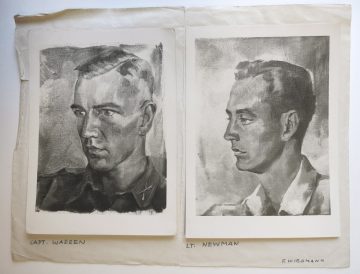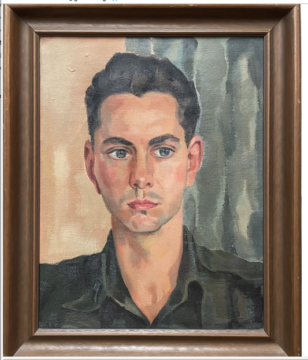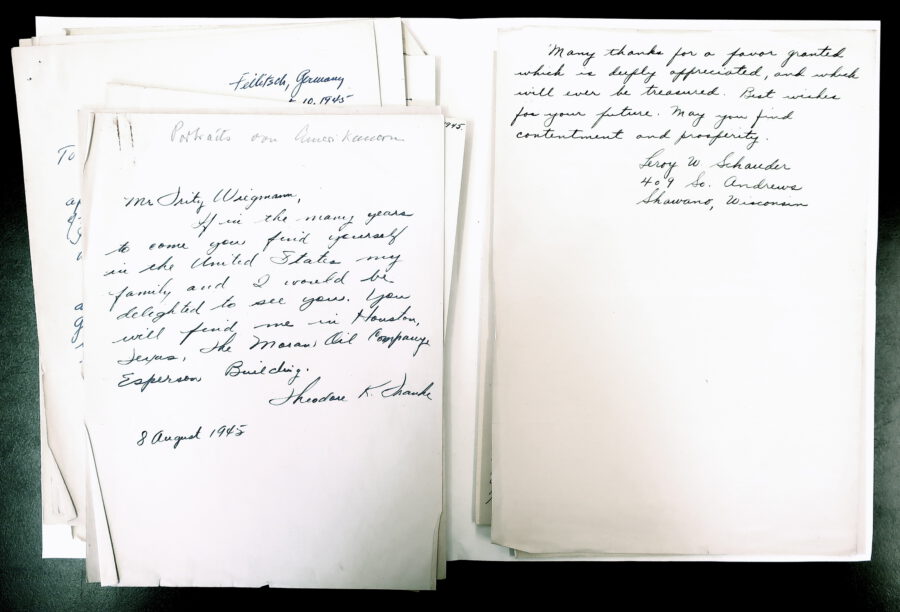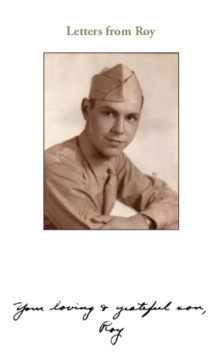I wrote in the article about Wiegmann’s years in Hof a.d. Saale (in German,LINK):
Survival – In February 1945, Fritz Wiegmann was transferred from Berlin to Hof an der Saale in Upper Franconia for the purpose of a gallstone operation and was overtaken there by American troops in April 1945. The population of the city on the border to the Egerland swelled at times to 55,200 inhabitants due to refugees and displaced persons. At that time he also spoke to Stauffenberg’s widow several times, already behind American lines in the home of a family friend. Explosives for the assassination of Hitler had been supplied by the Secret Service and should have formed a crater. But the barracks had been dug in. v.Trott was the ‚head‘ of the opposition; his request in England for an armistice was answered in the negative: unconditional surrender! (Personal communication in the late 1960s.) Then the Iron Curtain put the region in an extreme peripheral position, cutting it off from the formerly neighboring Bohemia, Vogtland and Thuringia. The borders passed only a few kilometers from the town. For a cosmopolitan free spirit and big city dweller like Fritz, the place with its traditionally pronounced local pride was the most unsuitable cornerWhile he was for a short time prisoner of war, American officers and soldiers became aware of the portrait painter Wiegmann. In the Frankfurt City Archives are four reproductions and sixteen personal letters of thanks of American soldiers, often with home addresses. Wiegmann’s first home, three miles south of Hof, in Oberkotzau, is mentioned there. If we ask what Wiegmann lived on then, his contacts with the American garrison is certainly part of the answer. (…….)
Cameron Quade contacts me on August 14, 2021
“…. You find attached the image of the portrait, a man named Leroy Schauder, a 1st Lieutenant and WWII medic in the US Army. You can see Wiegmann’s signature incised into the paint surface just above his proper right shoulder – it looks like he signed it using the end of his brush. It was brought to the gallery for appraisal by one of his descendants. If you happen to have an image from the archives or a letter from Schauder to Wiegmann I would be glad to see it! Thank you and all the best,…”
On August 20, I was able to report the find to the “Institut für Stadtgeschichte Frankfurt am Main”: “Among the 16 letters of thanks from Americans I found Schauder’s undated letter and could take a photo of the undated paper. All the best…“
Schauder Letter in the Bundle (on the right side)
Gallery and family are enthusiastic and in turn offer more information about the ancestor:„Here is a link with some more information on Leroy Schauder himself:“ the Link zum „Wisconsin Veterans Museum“ in 30 W Mifflin St, Madison, WI 53703 (LINK), Personal Record no. 3131 (LINK). The awards given are: Purple Heart(LINK) and Bronze Star (LINK). His short biography reads:
History
Leroy Schauder was born on June, 3 1920 in Clintonville, Wisconsin. He initially enlisted in the 135th Medical Regiment with the Wisconsin National Guard in 1937. During World War II he served in the 2nd Battalion, 385th Infantry Regiment of the 90th Division (Patton’s Third Army) from the end of the Normandy Campaign through the end of the war. He experienced combat and the aftermath of the Battle of Bastogne and the taking of Fort Köenigsmacher on the German side of the Mosel River. He was a member of the Veterans of Foreign Wars. He died on April 9, 2009 in Shawano, Wisconsin and is buried at Woodlawn Cemetery in Shawano.
In a seventy-five minute interview on the museum’s oral history program (Roy W. Schauder – OH 00588) 2006 he reported on acts of war, but also on the end of the war around 150 kilometers southeast of Hof and a trip to Europe in the footsteps of his unit. Official synopsis: „
„….. He describes how he learned about the Armistice signing by coming down into Pilsen (Czechoslovakia) from a hill and seeing German and American troops entering from both sides. Schauder describes the anti-climatic reaction by most men, how he got a shave and haircut and his thoughts of Pilsner beer. Because he had enough points, Schauder was transferred to the 99th Division (return-home division) where he was mess officer and worked with the medics to trace down venereal disease contacts.
He describes his efforts to reconnect with members of his WWII unit. Schauder has been a member of the VFW for 50 years (had no reason to use G.I. Bill (LINK) and mentions his reactions when he traveled, by rental car, the same route in Europe his unit did during the war.“
On October 4th, Leroy’s eldest daughter Kathryn (Cassy) Schauder Cantwell and her daughter Jane Cantwell Schmidt express their heartfelt thanks. They mention the project of a book with the war letters from France, Germany and Czechoslovakia that a cousin wants to publish and close with the comment:
„As far as Grandpa’s thoughts on the war – he was such a humble man. He never wanted to bring attention to himself. We know he saw some horrific things and had dear friends killed. His two brothers – Frank and Glen also served in the war while his parents maintained the Schauder Shoe Store. All three brothers returned safely from the war and were able to work together in their family shoe store business. Yes, please include the portrait as remaining in a private collection in the United States. We will look forward to reading your post.
Epilogue
Leroy SchauderAfter the war, Roy returned to his family in Shawano where he owned and operated Schauder Shoe Store with his parents and two brothers. He and Betty had two more children, Jeff and Debby. Roy’s wife, Betty, died in 1967. They had been married 25 years (since October 1942). Roy was a member of the First Presbyterian Church of Shawano where he was an ordaínedelder and trustee. He was also a member of the American Legion and a member of the Shawano Club and the Chamber of Commerce In 1982, Roy married Crystal Wochinski in Shawano. When Roy passed away April 13,2009, he was survived by his three children, five step-children, nine grandchildren and nine great-grandchildren.“
My personal assessment in a letter to the family on April 25, 2022:
„Fritz Wiegmann is not a famous expensive painter as his promising artistic career ended with the Third Reich. He still had gallery contacts in New York in 1931-33 (Gallery John Becker, Madison Avenue NY City, and through this gallery also in the Chicago World Exhibition) (LINK). At the age of about 30 he first had to go into exile in Mallorca and China, known at the time as a portrait painter and a friend of the American pianist George Copeland, (LINK). From 1938 – after his year in China with art collector Jean-Pierre Dubosc (LINK) – he led a modest life as a high school art teacher. During the war he looked after Berlin students who were being taught in Pilsen (!) because of the war. He did not become a soldier until 1944, but was discharged to the hospital in Hof in Bavaria because of severe hepatitis. I had Wiegmann as an art teacher for six years from 1955 and we became friends after he retired.
I have studied the Veterans Museum website. I think at some point in the future the picture should go there with the other documents. Five of his portraits of citizens from Hof, Germany, are kept in the „Bavarian Vogtland Museum“. Perhaps the museums will be interested in a German-American contact once in the future.
In Wiegmann’s portrait of your grandfather and father, two people and their very different destinies – and an entire family history – come together. Such a palpable constellation is a rarity! And I’m always amazed at the different cultures of remembrance in America and in Germany. Each concept has its upsides and downsides, virtues and vices, but this is a ticklish topic.“
ANNEX: LETTERS OF LEROY FROM FEILITZSCH, GERMANY, JULY 1945
FROM: Letters from World War II. Glenn Schauder, Leroy Schauder, Frank Schauder – 120pp. Published 2017, The Write Type . Reno, Nevada – Edited by Candy (Schauder) Kiel – Copyright with the family.
pp.77/78. – 12 July 1945 – Feilitzsch, Germany
Feilitzsch is a municipality in the Upper Franconian district of Hof and the seat of the administrative community Feilitzsch. The community in the Bavarian Vogtland is about four miles north of the city of Hof on the A 72 and A 93 motorways. Since Schauder was transferred again at the beginning of August, one can assume that Wiegmann portrayed him that month. I am printing the photo introductory to the publication on the left for comparison.
Dear Mom & Dad,
Guess I’d better write a short note and give you my new address. I was transferred quite suddenly yesterday, and consider it a good break. This outfit is made up of all *high point men, eligible for return to the states & is scheduled to leave for the states in Dec. That is a long time yet, but it certainly is a step in the right direction for me. We live like kings here in a German Baron’s home, which I can only describe as being “out of this world.” Just now I finished a little chat with the Countess**. Some stuff, eh? It’s a coincidence, but about four months ago, my old Bn. fought for this place & our CP was in the very building where I am at present. I have a huge room, double exposure & sun porch. Two maids clean up the place for me & I am rapidly becoming a lazy man in such elegant surroundings. Looks like I might have gotten a break after all, doesn’t it?
Guess my mail will be screwed up for awhile now, but I’ll keep you posted on what goes on with Roy. I have a slight head cold from doing so much riding around lately, but otherwise the old morale has really been boosted. At least now, I have something a little more definite to look forward to. Am with a grand bunch of officers & men, but I sure felt bad to have to leave the old gang after going thru so much with them. But, I guess it is all for the better. By now.
Your loving son, Roy
* The US Army used a point system at the end of World War II in Europe to determine which soldiers were eligible to be repatriated to the United States for discharge from military service. In general, “those who had fought longest and hardest should be returned home for discharge first.” (Ed.)
**** LINK Feilitzsch – Aristocratic family, Feilitzsch – baroque palace (family-owned to this day)
pp.78/79. – 20 July 1945 – Feilitzsch, Germany
Dear Mom & Dad:
Hello, good people. I trust you are both in best of health, and that business is proceeding at
its usual good pace. How ‘bout it? Report. I’m feeling fine, and outside of my transfer screwing up my mail, things are going very smoothly for me. I lead an extremely lazy life, getting more than enough sleep, doing very little work, and living like a king. I have my room fixed up nice, and managed to get a new radio, so I can hear all the latest news, and the best programs from the states. The Japs are sure catching hell now, and I’m glad to hear it. I hope the piece of camouflage silk reaches you alright. I’m having a couple pair of pajamas, and sheets for my bed made from it. Pretty ritzy, I’d say. Now that we can speak to German civilians, I’m trying to improve my “Sprache,” but I guess I’ll never get as good as you at it, Dad. But I get along with what I know. I hope I never have to learn Japanese.
I met a German girl (strictly business) the other day, whose home is in Milwaukee, Wisconsin. She spoke very good English and had come over here six years ago, but since the war started, she couldn’t get back. Boy, was she homely tho! She oughta stay over here. Her name was Scheider. Strange things happen, don’t they?
I can’t tell you how badly I want to get home, and away from all of this crap over here. The people are in sad shape, with thousands of them wandering the roads, tired, dirty, hungry & homeless. Perhaps it serves them right for all the misery they caused others. I have verylittle sympathy for them, myself, although I can understand how people back home might be sympathetic, because they haven’t seen what the Germans had done to other countries and the people. To hell with them, and I mean it. I’d better stop or I might start swearing. See you in ’46. Until then, my prayers are with you, my two swell brothers & my wonderful wife & daughter.
Your loving son – Wee Woy – What a name!




